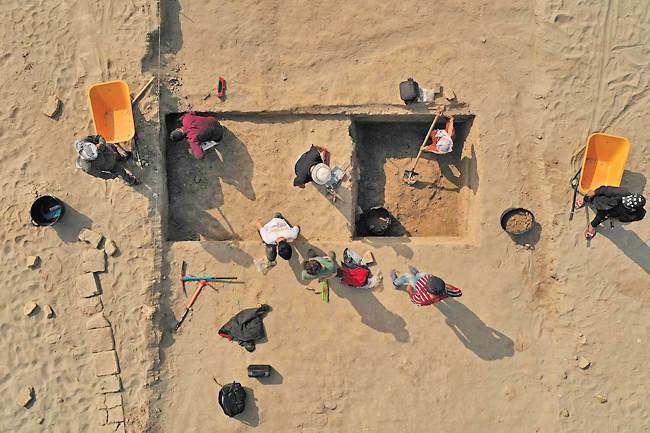NASIRIYAH, IRAQ (AFP) – After war and insurgency kept them away from Iraq for decades, European archaeologists are making an enthusiastic return in search of millennia-old cultural treasures.
“Come and see!” shouted an overjoyed French researcher recently at a desert dig in Larsa, southern Iraq, where the team had unearthed a 4,000-year-old cuneiform inscription.
“When you find inscriptions like that, in situ, it’s moving,” professor of Mesopotamian civilisation at the College de France in Paris Dominique Charpin said.
The inscription in Sumerian was engraved on a brick fired in the 19th Century BCE.
“To the deity Shamash, king Sin-iddinam, king of Larsa, king of Sumer and Akkad,” Charpin translated with ease.
Behind him, a dozen other European and Iraqi archaeologists kept at work in a cordoned-off area where they were digging.
They brushed off bricks and removed earth to clear what appeared to be the pier of a bridge spanning an urban canal of Larsa, which was the capital of Mesopotamia just before Babylon, at the start of the second millennium BCE.

“Larsa is one of the largest sites in Iraq, it covers more than 200 hectares,” said researcher at France’s National Centre for Scientific Research Regis Vallet, heading the Franco-Iraqi mission.
The team of 20 people have made “major discoveries”, he said, including the residence of a ruler identified by about 60 cuneiform tablets that have been transferred to the national museum in Baghdad.
Vallet said Larsa is like an archaeological playground and a ‘paradise’ for exploring ancient Mesopotamia, which hosted through the ages the empire of Akkad, the Babylonians, Alexander the Great, the Persians and Islamic rulers.
However, the modern history of Iraq – with its succession of conflicts, especially since the 2003 United States (US)-led invasion and its bloody aftermath – kept foreign researchers at bay.
Only since Baghdad declared victory in territorial battles against the Islamic State group in 2017 has Iraq “largely stabilised and it has become possible again” to visit, said Vallet.
“The French came back in 2019 and the British a little earlier,” he said. “The Italians came back as early as 2011.”
In late 2021, said Vallet, 10 foreign missions were at work in the Dhi Qar province, where Larsa is located.
Iraq’s Council of Antiquities and Heritage director Laith Majid Hussein said he is delighted to play host, and is happy that his country is back on the map for
foreign expeditions.
“This benefits us scientifically,” he told AFP in Baghdad, adding that he welcomes the “opportunity to train our staff after such a long interruption”.
Near Najaf in central Iraq, Ibrahim Salman of the German Institute of Archaeology is focussed on the site of the city of Al-Hira.
Germany previously carried out excavations here that ground to a halt with the 2003 US-led invasion that toppled Saddam Hussein.
Equipped with a geomagnetic measuring device, Salman’s team has been at work in the one-time religious city that had its heyday under the Lakhmids, a pre-Islamic tribal dynasty of the 5th and 6th Centuries.
“Some clues lead us to believe that a church may have been located here,” he explained. He pointed to traces on the ground left by moisture which is retained by buried structures and rises to the surface.
“The moistened earth on a strip several metres long leads us to conclude that under the feet of the archaeologist are probably the walls of an ancient church,”
he said.
Al-Hira is far less ancient than other sites, but it is part of the diverse history of the country that serves as a reminder, according to Salman, that “Iraq, or Mesopotamia, is the cradle of civilisations. It is as simple as that!”






